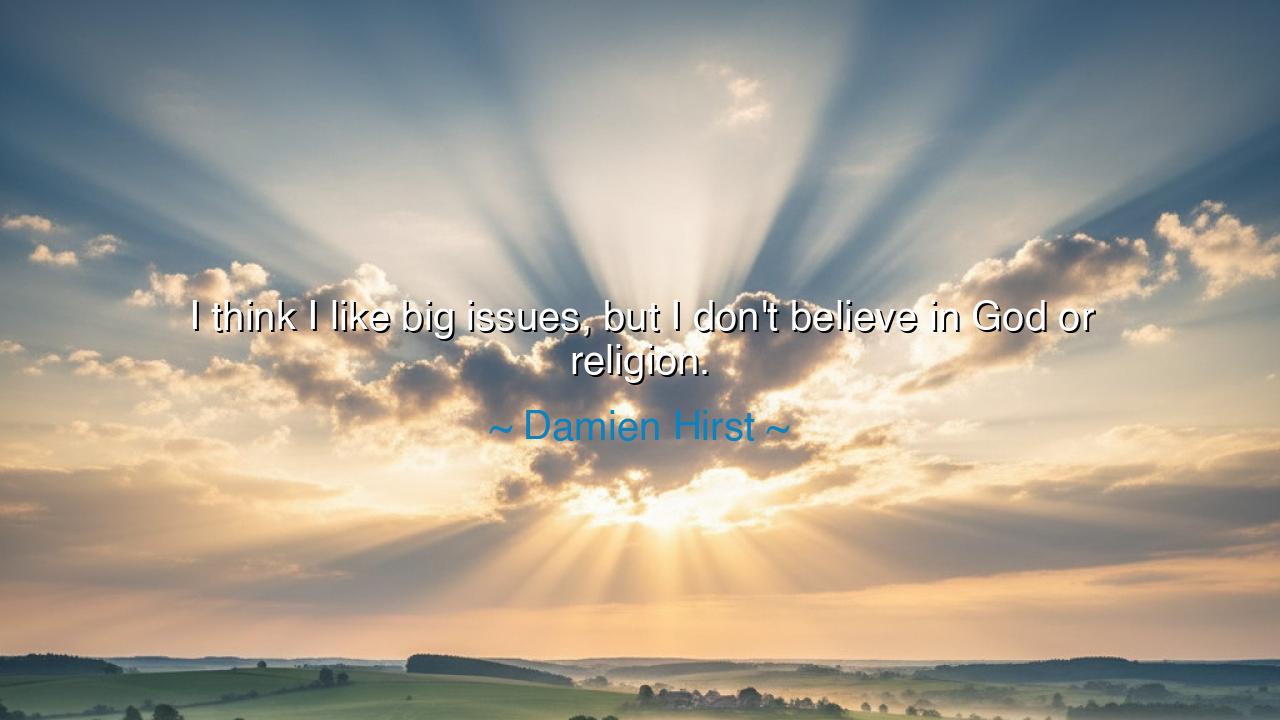
I think I like big issues, but I don't believe in God or






In the vast expanse of human thought, where the search for meaning and purpose has been a constant pursuit, Damien Hirst offers a reflection that resonates with the modern world: "I think I like big issues, but I don't believe in God or religion." This statement, coming from a contemporary artist known for his provocative works, delves into the relationship between art, philosophy, and spirituality. Hirst’s words suggest a rejection of traditional religious structures in favor of intellectual engagement with the big issues of life—issues that concern not just personal faith but the collective human condition, the mystery of existence, and the eternal questions that have plagued humanity for millennia.
In the ancient world, there was a constant tension between the philosophical pursuit of truth and the religious frameworks that sought to explain the mysteries of existence. Socrates, the father of Western philosophy, famously questioned the traditional religions of Athens. He did not deny the divine but sought to engage in a deeper examination of what the divine truly represented. For Socrates, faith in the gods was not about blind obedience to dogma but about a rational exploration of life’s deepest questions. He sought to understand virtue, wisdom, and justice not through religious rituals but through critical thought and dialogue. In a similar vein, Hirst's rejection of God and religion might reflect a desire to confront the big issues—the existential questions of life, death, and meaning—through art and intellectual inquiry, rather than the answers provided by traditional religion.
Much like Socrates, Hirst seems to challenge the limitations of conventional religion in his work. His art—often controversial and deeply philosophical—explores themes of life and death, mortality, and eternity. In his famous piece, "The Physical Impossibility of Death in the Mind of Someone Living," a shark preserved in formaldehyde becomes a striking metaphor for the tension between life and death, forcing the viewer to confront the uncomfortable realities of mortality. Hirst’s work raises questions about the nature of existence and spirituality, echoing the same philosophical concerns that the ancient philosophers grappled with: What is the purpose of life? What happens after death? Does religion provide meaningful answers, or are we left to find our own truths in the vast unknown?
The great philosophers and thinkers throughout history have consistently engaged with these big issues—the meaning of life, the nature of existence, and the role of religion in shaping human understanding. Friedrich Nietzsche, a towering figure in modern philosophy, famously declared, "God is dead." His words were not a literal statement but a commentary on the decline of religious authority in the modern world. Nietzsche saw the death of traditional religion as a profound challenge for humanity, one that forced individuals to confront the meaning of life without relying on the comforts or certainties of religious belief. Nietzsche’s exploration of the "Übermensch" (the superman or overman) suggests that without God or religion, humans must create their own values and meaning, free from the constraints of religious dogma.
Similarly, Jean-Paul Sartre, a leading figure in existentialism, argued that life has no inherent meaning and that it is up to each individual to create their own purpose through action and choice. Like Hirst, Sartre rejected the need for divine or religious explanations for existence, instead emphasizing the power and responsibility of the individual to confront the big issues head-on, without relying on external authorities. Existentialism teaches that in the absence of a prescribed meaning or purpose, human beings must find authenticity in the face of the absurdity of life. For Hirst, like Sartre, art becomes the vehicle through which to confront and explore these themes, offering no easy answers but compelling us to look deeper into the human experience.
Yet, despite Hirst’s rejection of religion, his work often engages with spiritual and philosophical themes that draw upon the same existential questions that religion attempts to answer. Through his art, Hirst forces the viewer to confront the big issues: the fragility of life, the certainty of death, and the ambiguity of meaning. In many ways, his rejection of traditional faith mirrors the ancient search for truth, where the journey toward understanding is not about receiving answers from a divine authority but about engaging with life’s mysteries through reason, art, and experience.
The lesson in Hirst’s words and his work is one of intellectual courage—the willingness to confront life’s biggest questions without relying on the security of established answers. Religion, in its many forms, provides a framework through which people have historically sought to understand the world. But as the ancient and modern philosophers alike have shown, the quest for meaning often lies in the personal journey—a journey that does not depend on inherited beliefs or external authorities, but on the individual's search for truth and meaning. This search is not necessarily against religion but an acknowledgment that the big issues of life require active, personal engagement with both reason and experience.
In practical terms, we must learn to question the world around us, not to reject faith entirely, but to seek understanding through personal exploration, whether it is through art, philosophy, or spirituality. Like Hirst, we must confront the big issues head-on, allowing our own curiosity and insight to guide us. Let us not be content with easy answers but seek out the deep, challenging questions that define our existence, using every tool at our disposal to explore, reflect, and grow. In doing so, we will come closer to authenticity and understanding, much like the great thinkers who came before us.






AAdministratorAdministrator
Welcome, honored guests. Please leave a comment, we will respond soon